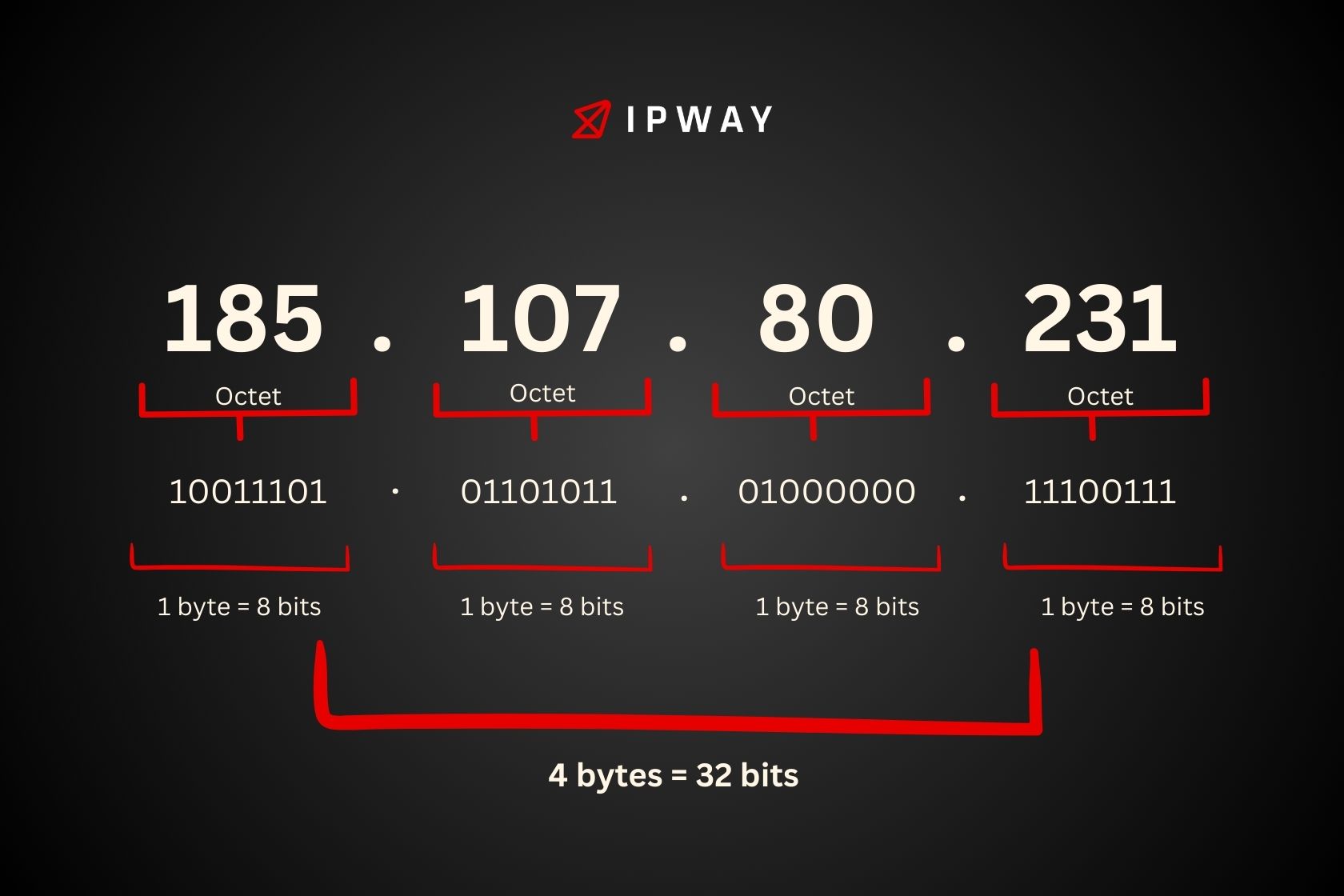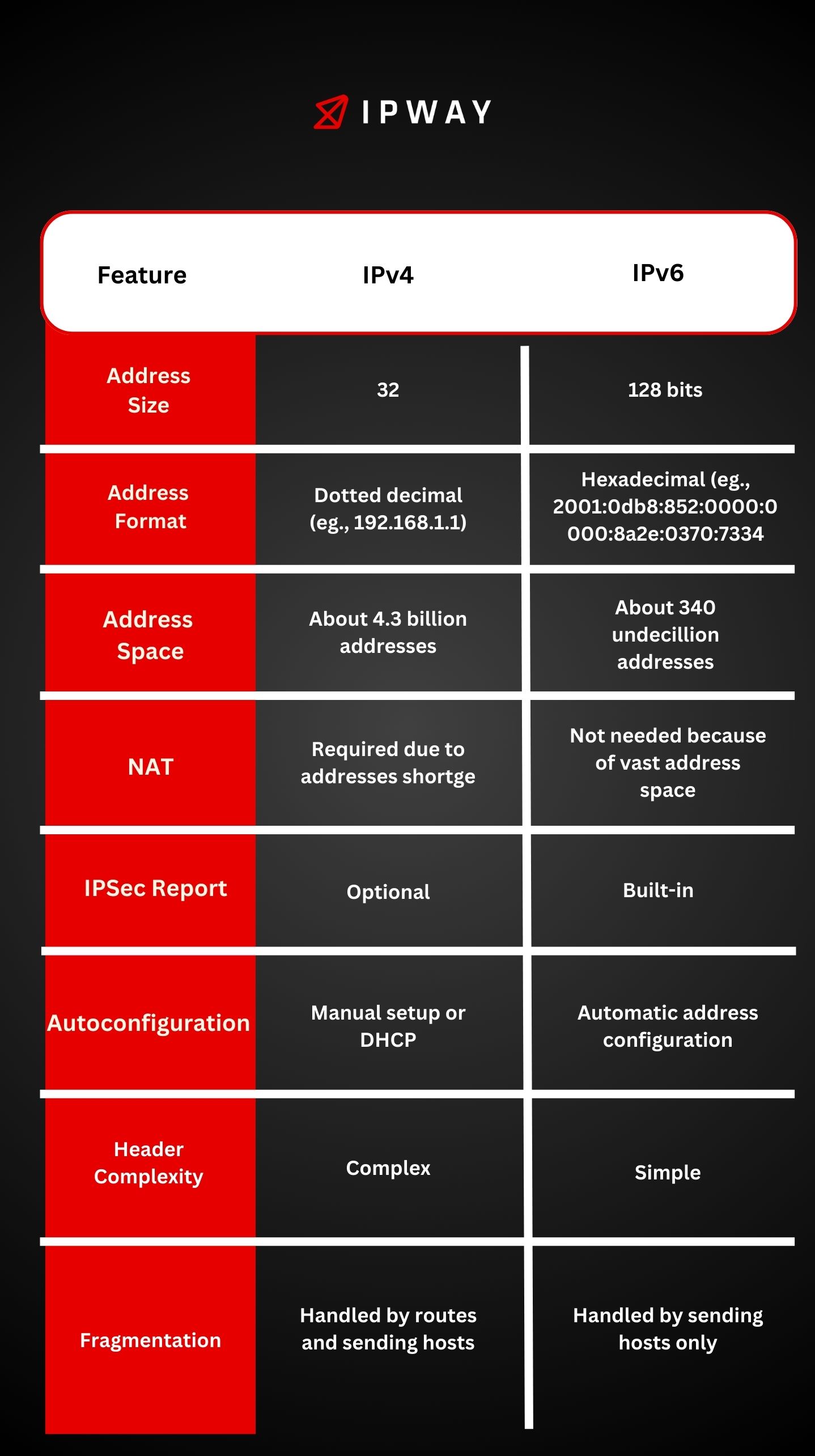The internet relies on a system of unique identifiers known as Internet Protocol (IP) addresses. The two primary versions in use today are IPv4 vs IPv6. This article delves into the differences and similarities between these protocols, including their structures, speed, security features, and practical applications.
What is IPv4?
IPv4 short for Internet Protocol version 4 is the iteration of the Internet Protocol and was the initial one to gain widespread usage beginning in 1982. It continues to be utilized for device identification on networks thanks, to its proven track record and widespread acceptance.
A common IPv4 address appears in this format; 192.168.0.1. It comprises four numbers, each falling between 0 and 255 divided by dots. Each number denotes an octet equivalent, to 8 bits forming the address as a 32 bit series utilized for distinctive identification of connected devices.
In 2015, it was officially announced the US had run out of IPv4 addresses.

What Is IPv6?
IPv6, also known as Internet Protocol version 6 represents the recent iteration of the Internet Protocol. Similar to IPv4 it plays a role in enabling the recognition and directing of data between computers, within networks.
Crafted by the Internet Engineering Task Force (IETF) IPv6 was created to address the constraints of its predecessor, IPv4 in terms of address scarcity. It attained Draft Standard status in December 1998. Was officially recognized as an Internet Standard in 2017.
An instance of an IPv6 address would be; 2001;0db8;85a3;0000;0000;8a2e;0370;7334. This specific address consists of eight 16 bit values separated by colons making up a total of 128 bits, which is notably larger, than the 32 bit structure of IPv4.
Similarities Between IPv4 and IPv6
Even though IPv4 and IPv6 have differences they also have some key similarities. Both protocols aim to assign addresses to network devices, for accurate routing and communication. They both have error checking mechanisms and packet fragmentation features to uphold data integrity and support data transmission.
Unique Device Identification: Both IPv4 and IPv6 provide a way to distinguish devices in a network, which’s crucial, for ensuring that data packets are routed correctly from their origin to their intended destination.
Routing Capabilities: Both protocols enable routing, which means guiding data packets through networks to reach their intended destination. Routers utilize the addresses found in IPv4. Ipv6 headers to determine how to forward the packets.
Error Checking and Packet Fragmentation: IPv4 and IPv6 utilize error checking techniques to guarantee the transmission of data packets without any corruption. Moreover both protocols manage fragmentation enabling large packets to be divided into smaller segments, for transmission and later reconstructed at the intended destination.
Manual and Automated Configuration: Network administrators have the ability to set up both protocols manually. IPv4 commonly requires configuration or Dynamic Host Configuration Protocol (DHCP) while IPv6 allows for manual setup as well as more advanced automated options such, as Stateless Address Autoconfiguration (SLAAC) and DHCPv6.
Support for Multicast and Broadcast: Both IPv4 and IPv6 enable addressing facilitating the transmission of data to multiple destinations at once. In addition IPv4 permits broadcast addressing to convey data to all devices within a network whereas IPv6 leverages multicast for functionalities but in a more streamlined approach.
Coexistence and Transition: During the switch from IPv4 to IPv6 both protocols are set up to work together smoothly. Techniques such as using stack and tunneling help maintain compatibility and seamless operation, between the two protocols throughout this transition phase.
The commonalities, between IPv4 vs IPv6 underscore the core principles they share even though they differ in address capacity security attributes and additional advanced capabilities.
IPv4 vs IPv6: which one to use?
Choosing between IPv4 and IPv6 depends on several factors, each crucial to network performance, scalability, and future-proofing.
Compatibility: IPv4 remains the commonly used protocol in various devices and networks. Many older systems and a significant number of applications are mainly built for IPv4 making it the preferred option for numerous users. Nevertheless there is a rise, in IPv6 compatibility as modern devices and operating systems are starting to embrace IPv6 support widely.
Address Space: IPv6 has a benefit over IPv4 due to its extensive address space. While IPv4 only provides around 4.3 billion addresses with its 32 bit scheme it falls short in meeting the growing demand, from the increasing number of internet connected devices. On the hand IPv6s 128 bit address space boasts approximately 340 undecillion addresses solving the problem of address depletion and enabling better and more adaptable IP address distribution.
Performance: IPv6 may provide performance compared to IPv4, in specific situations. Unlike IPv4 IPv6 does not rely on Network Address Translation (NAT) to manage address limitations allowing data packets to travel directly and effectively. This can result in latency and quicker data transfer speeds. Also the simplified header format of IPv6 can enhance routing efficiency.
Security: Security is also a factor to think about. IPv6 was created with security as a priority incorporating backing for IPsec (Internet Protocol Security) which offers encryption from end to end ensures data integrity and authentication. Even though IPsec can be applied in IPv4 it’s not mandatory. Is used less frequently. The removal of NAT, in IPv6 makes network setups simpler. Can lower security risks related to NAT traversal.
Transition and Coexistence: In the phase of moving from IPv4 to IPv6 numerous networks will have to operate both protocols at the time. By using dual stack implementation devices can support both IPv4 and IPv6 ensuring compatibility and enabling a transition. Additionally tunneling methods involve encapsulating IPv6 packets, within IPv4 packets, which aids in connecting the two protocols during this period.
Future-Proofing: When it comes to planning for the run IPv6 emerges as the top pick because of its scalable nature and capacity to accommodate the increasing count of internet connected gadgets. Businesses aiming to safeguard their networks for the future ought to think about transitioning to IPv6 so they can stay ready, for technological progressions and the ongoing growth of the Internet of Things (IoT).
Although IPv4 is still widely used and works with current systems IPv6 provides notable benefits in terms of address capacity, speed, security and future readiness. Deciding whether to use IPv4 or IPv6 depends on network needs, compatibility issues and strategic objectives for the long term. Most businesses opt for a dual stack strategy during the migration phase to enjoy the advantages of IPv6 while staying compatible, with IPv4.

IPv4 vs IPv6 security
When it comes to security IPv6 offers advantages compared to IPv4. While both protocols have security features IPv6 was created with a focus, on improving security by addressing vulnerabilities that exist in IPv4.
Built-in IPsec
IPv6 comes with a security enhancement; the mandatory inclusion of Internet Protocol Security (IPsec). IPsec comprises a set of protocols that offer encryption, data integrity and authentication from end to end at the IP level. Although IPsec can be used with IPv4 its adoption is not widespread as it is optional. The compulsory integration of IPsec in IPv6 guarantees a level of security for transmitting data, across networks.
Simplified Network Configuration
IPv6 makes network setup easier with Stateless Address Autoconfiguration (SLAAC). SLAAC enables devices to create their IP addresses by using local details and router advertisements. This eliminates the need, for configuring IP addresses or relying on Dynamic Host Configuration Protocol (DHCP) decreasing the chances of setup mistakes and security issues.
No Need for Network Address Translation (NAT)
IPv4 commonly uses Network Address Translation (NAT) because of its address capacity. NAT converts IP addresses to a public IP enabling multiple devices to utilize a single public IP address. Nonetheless NAT brings about security concerns such as the possibility of address conflicts and challenges in monitoring and safeguarding individual devices. In contrast IPv6 with its address range does away with the necessity, for NAT making network management simpler and decreasing related security vulnerabilities.
Enhanced Header Structure
The design of the IPv6 header aims to enhance efficiency and security compared to IPv4. It incorporates a Flow Label field to enhance Quality of Service (QoS) by recognizing and controlling traffic flows. Moreover IPv6 headers are more straightforward and efficient lessening the workload on routers and enhancing network performance, as a whole.
Improved Support for Mobile Networks
IPv6 comes with functionalities that boost security and effectiveness in networks. Mobile IPv6, also known as MIPv6 enables gadgets to switch between various networks without altering their IP address. This ensures connections and heightens security for mobile communication, which is crucial given the rising number of mobile devices, in use.
Address Spoofing Prevention
IPv6 addresses come with features to stop address spoofing, an attack where someone pretends to be a different device by using a fake IP address. The increased address space and better address management, in IPv6 make it more challenging for attackers to carry out such spoofing attacks ultimately boosting the networks security.
Final IPv4 vs IPv6 Comparison
Address pace
- IPv4: A 32 bit address system is used, providing 4.3 billion distinct addresses. Due to this constraint the available addresses are nearly depleted, requiring solutions such, as Network Address Translation (NAT) to prolong the use of the address pool.
- IPv6: The system uses a 128 bit addressing system offering around 340 undecillion addresses. This vast address range can easily cater to the increasing amount of internet connected devices. Allows for future growth without relying on NAT.
Speed and Performance
- IPv4: Address scarcity often necessitates the use of NAT leading to delays and making network setups more complex. The varied header format of IPv4 can also increase the workload, on routers potentially affecting their performance.
- IPv6: IPv6 does not need NAT because of its address range, which enables simpler and more direct data packet routing. The fixed length headers of IPv6 are crafted to be more effective lessening the workload, on routers and potentially improving the speed and performance of the network as a whole.
Security
- IPv4: Security functions, like IPsec are not commonly used as they are considered optional. Using NAT can complicate things. Introduce more potential security risks, which can make securing networks a more challenging task.
- IPv6: Created with backing, for IPsec guaranteeing complete encryption, data integrity and verification. Removing NAT lessens the chance of security weaknesses and IPv6s structure incorporates improved methods to hinder address forgery and other forms of attacks.
Configuration and Management
- IPv4: IPsec is included to provide support guaranteeing secure encryption, data integrity and authentication from start to finish. By removing NAT the chances of security vulnerabilities are. Ipv6 features improved methods to prevent address spoofing and various attacks. Address assignment requires setup or DHCP which may lead to errors and pose management difficulties. Additionally network administration becomes more complex, with the inclusion of NAT and other alternative solutions.
- IPv6: Automated setup features such as Stateless Address Autoconfiguration (SLAAC) and DHCPv6 are, in place to make network management easier. The uncomplicated address assignment and lack of NAT make network configuration simpler. Decrease administrative tasks.
Header Complexity
- IPv4: The header contains 12 fields of varying lengths, which can complicate processing, for routers. This added complexity may result in inefficiencies when transmitting and routing data.
- IPv6: A fixed length header, with 8 fields is used for its simplicity and efficiency. This structured header helps routers process data faster leading to network performance.
Coexistence and Transition
- IPv4 vs IPv6: During the transition from IPv4 to IPv6, both protocols can coexist through dual-stack implementation, where devices and networks run both protocols simultaneously. Tunneling methods allow IPv6 packets to be transmitted over IPv4 infrastructure, ensuring compatibility and interoperability during the transition period.
Conclusion
IPv4 vs IPv6 play roles in keeping the internet running smoothly each bringing its own advantages and drawbacks. Despite IPv4s continued dominance IPv6 brings enhancements in terms of address capacity security features and operational efficiency.
As cyberspace expands the shift towards IPv6 is bound to happen yet both protocols are expected to coexist for a long time. Having a grasp of the variances and similarities between IPv4 vs IPv6 is crucial for making well informed choices regarding network administration and ensuring that digital infrastructure remains up, to date.
